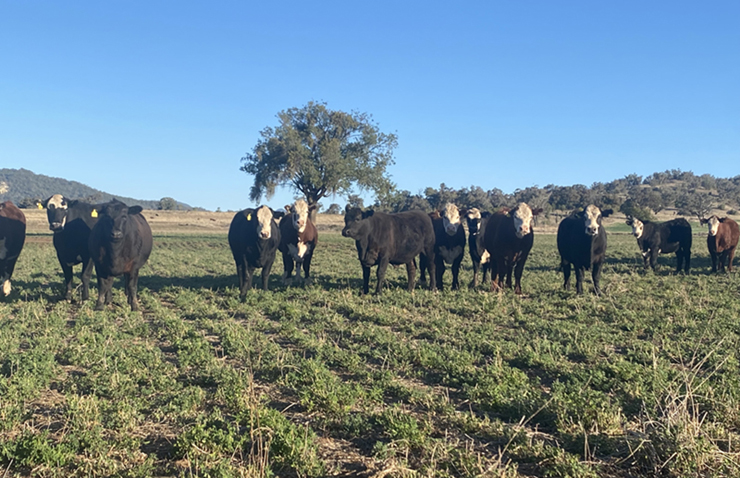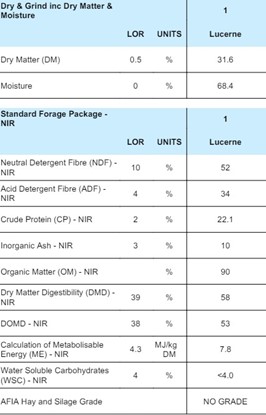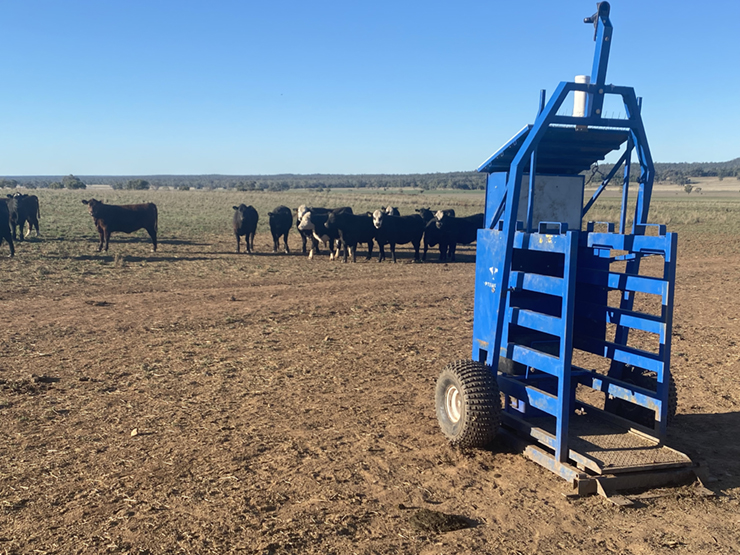Producer case study: C McGlashan
Property Owner: C McGlashan
Property Name: Cheriton
Location: Bugaldie, NSW
Annual rainfall: 650mm
Property size: 2,000ha
Enterprise: beef production for supermarket trade and cereal production
Pasture type: lucerne, digit and clovers
Soil type: sandy loam clay with some basalt
The Warrumbungle Mixed Farm Producer Group (WMFPG) was developed to increase the knowledge and skills of the producers involved through joint learning and knowledge sharing.
Members of the WMFPG are a group of mixed farmers grazing dual-purpose and winter crops.
There was an opportunity for these producers to utilise feeding equipment and on-farm grain stores to increase weight gain of stock grazing forage/dual-purpose crops and turn stock off more quickly, increasing carrying capacity and, therefore, profitability.
The Grain on Grass MLA Producer Demonstration Site (PDS) project was developed to demonstrate the use of supplementing grain while grazing to:
- Increase liveweight gain per head per day by 20%.
- Improve carrying capacity through expedited stock turn-off by 3.5%.
- Showcase the utility of grain supplementation during forage crop grazing in preserving carcass quality and meeting market specifications while reducing grazing days by 13%.
- Raise awareness among core producers and 25% of observers regarding the importance of feed tests in assessing feed quality.
- Increase awareness among core producers about utilising carcase feedback to ensure compliance with target market specifications.
- Enhance the skills of 75% of core producers in formulating supplementary feeding rations through the utilisation of feed tests.
Background
The McGlashan family grow cereal crops and produce Angus and Angus-cross steers for the domestic supermarket trade on their property near Bugaldie NSW.
Their steers are finished on lucerne, digit and clover-based pastures to a target weight of approximately 520kg.
Grain on Grass demonstration at Cheriton
The Grain on Grass demonstration at the McGlashans’ ‘Cheriton’ station looked at supplementing Angus and Angus-cross steers grazing on lucerne pasture over winter (Figure 1).

Figure 1: Angus and Angus cross steers in the treatment group on Lucerne crop
The demonstration commenced on 17 July 2023 and concluded after approximately 60 days. The date the final weights were recorded on varied depending on when steers reached their target weight to suit the McGlashans’ enterprise.
During the demonstration period, the control group received no supplement, while the treatment group were fed 8kg/hd/day of total mixed ration (wheat: 85%, hay: 10%, pellet: 5%) in a self-feeder.
The cattle were split across two lucerne paddocks, with 93 head in the control group and 59 head in the treatment group.
The control group had an average start weight of 281kg, while the treatment group had an average start weight of 454kg.
Due to the operational constraints of the demonstration site, the differences in starting weights of the control and treatment groups were unavoidable.
The McGlashans finish their heavier steers on a grain assisted ration, while the lighter steers are pasture fed until they reach approximately 420kg.
A feed test of the lucerne pasture was done on 17 July 2023, showing a metabolisable energy (ME) content of 7.8MJ/kg Dry Matter (DM) and Crude Protein (CP) of 22.1% (Table 1).
Table 1: Feed test results for Lucerne

The CP content was well above the weight gain requirements for the weaner stock.
However, the ME was below the requirement for weight gain.
This site utilised Optiweigh units in both groups for the collection of liveweights during the demonstration (Figure 2).

Figure 2: Optiweigh unit in paddock
This meant they were able to get regular liveweights without having the additional time and labour component of mustering animals into the yards for weighing.
Results
Increase average daily gain by 20%
The final weights for the demonstration were recorded in October 2023.
The treatment group had an average daily gain (ADG) of 1.6kg/day and the control group had an ADG of 1.0kg/day (Table 2).
This was a 48% increase in ADG over the 60-day period.
However, the large difference in starting weights makes it difficult to compare weight gain on a statistical basis.
Factors to consider when using different starting weights would be the greater expected compensatory gain of lighter animals compared to heavier animals.
Improve carrying capacity and reduce grazing days
The increase in weight gain within this demonstration would allow for supplemented animals to meet market specifications by day 32 (approx.) of the current business plan of a 90-day finishing period – an average of 58 days faster than animals receiving no supplement.
Table 2: Average daily gain and $ gain per head per day
|
|
Total ADG (kg) |
$/kg |
$ Gain/hd/day |
$ Gained through supplementary feeding |
|
Control group |
1.05 |
$3.00 |
$3.15 |
|
|
Treatment Group |
1.56 |
$3.00 |
$4.67 |
$1.52 |
Cost-benefit analysis
Results for the cost-benefit analysis are shown in the tables below.
The treatment group was recorded to have an estimated expense of $3.27/hd/day in labour and grain costs (Table 3).
Table 3: Treatment group costs of grain and labour
|
Treatment group |
|
|
Total cost of ration |
$9,558 |
|
Total cost of labour |
$90 |
|
Cost ration + labour |
$9,648 |
|
Cost ration + labour (per tonne) |
$405 |
|
Cost ration + labour (per kg) |
$0.41 |
|
Ration consumed per day (kgs) |
472 |
|
Ration consumed per head (kgs) |
8 |
|
Cost/hd/day |
$3.27 |
|
Cost/hd/demo Period |
$163.53 |
This amounted to a loss per head of -$1.75/day.
When looking at the duration of the demonstration period, a significant loss of -$88.14 was incurred for the grainfed animals, making it hard to justify the cost of grain feeding in this instance.
Evaluation
The results from this demonstration site showed that while it was possible to achieve a 48% increase in liveweight by supplementing with grain, it wasn’t a true comparison as the start weights of each group were so different.
Animals selected for the treatment group were based on a liveweight above 380kg to be in line with the producer’s commercial operation of finishing cattle to a target weight of 520kg for the domestic supermarket trade.
The high cost of the ration at $405/t or $0.45/kg meant that supplementing was not economically viable in this case.
The results from this demonstration site indicated that the timing of the demonstration was unsuitable and may have shown better results if conducted later in the season when pasture quality had decreased.
The cost benefit analysis showed that supplementing 8kg of grain/head would equate to a loss of -$1.75/head - amounting to a large loss of -$88.14/head over the demonstration period (Table 4).
Table 4: Cost benefit per head per day and for the duration of the demonstration period
|
Cost benefit/day/head |
Cost benefit/demo period/head |
||||
|
Cost/hd/day ($) |
$ Return/hd/day |
Cost benefit ($) |
Cost/hd/demo period ($) |
$ Return/hd |
Cost benefit ($) |
|
3.27 |
1.52 |
-1.75 |
163.53 |
75.38 |
-88.14 |
Additionally, the law of diminishing returns may have been a factor, and animals could have been supplemented with less grain and still produced a similar result.
The amount of grain supplemented also presented a logistical complication as feeding smaller amounts in the self-feeders resulted in them blocking up. In conclusion, the value of supplementing with grain is dependent on the seasonal conditions, as well as being hugely dependent on grain prices.
It may be of most value to grain feed when grain prices are low or in situations where lower quality grain stores can be utilised.
In this case, the cost of grain was too high to provide an economic return from supplementation.



